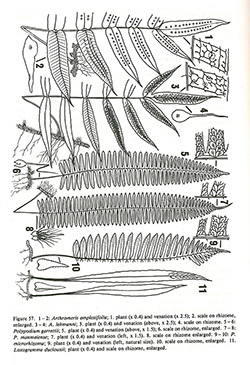e-Flora of Thailand
Volume 3 > Part 4 > Year 1989 > Page 571–572 > Polypodiaceae > Polypodium
4. Polypodium garrettii C.H.Wrightwfo-0001227625
Kew Bull. 1930: 174; Ching, Contr. Inst. Bot. Natl. Acad. Peiping 2: 49. 1933. Fig. 57. 5–6.
Accepted Name : Goniophlebium lachnopus (Wall. ex Hook.) J.Sm.
Gen. Fil.: t. 51. 1840.
Description : Rhizome wide-creeping, 2.5–3 mm diam., dark brown to nearly black, densely covered with scales; scales thin, ovate with long tails, about 1 mm diam. with tails about 5 mm in length, irregularly toothed at margin, light brown, shining, clathrate. Stipes stramineous, 6–7 cm long, densely hairy upwards. Laminae linear-lanceolate, round at base, acuminate at apex, 25–50 by 6–12 cm, pinnatifid to pinnatisect; rachis stramineous, densely hairy throughout, scaly beneath; lobes up to 40 pairs, the upper ones gardually becoming smaller, the basal one or two pairs slightly deflexed, sometimes separated by a little longer ones next above or continuous with very narrow wing of rachis, middle lobes the largest, patent, straight, acute at apex, subentire or very slightly toothed at margin, narrowly oblong or gradually narrowing from base to apex, up to 6 by about 1 cm; veins reticulate to form a single row of large costal areoles along each side of costa, each areoles containg a simple included veinlet, the other veins free, the apex a little inside the margin of lobes, hardly visible; rather thick, green, densely pubescent on both surfaces. Sori round, terminal on the included simple veinlets, thus in a single row along each side of costa, medial or closer, up to 1.5 mm diam., superficial.
Thailand : NORTHERN: Chiang Mai (Doi Chiang Dao, Doi Inthanon – type).
Distribution : Endemic.
Ecology : On mossy tree-trunks in dense forests on limestone areas at 1,000–1,800 m alt.
Notes: In the character of fronds, this species is close to Polypodium wattii in the Himalayas and N Vietnam, but distinct from the nominal species in the features of rhizome: in P. wattii rhizome is almost naked and glaucous, as this is sometimes referred to a variety of P. niponicum. Another close species is P. transpianense in Taiwan, which is distiguished by less densely scaly rhizome, little deflexed lowest lobes which are continuous to the next above with wings or rachis more than 1 mm in breadth, and usually two rows of aroles are at each side of costa. In spite of such apparent similarity to the species of the group of P. niponicum, P. garrettii seems to be a close ally of P. amoenum, from which it is different in the dense hairy surfaces of the fronds.
E-version notes : For more details see Ferns of Thailand, Laos and Cambodia.

